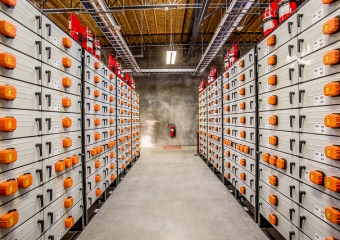

Photo of energy storage unit by Portland General Electric is licensed under CC BY 2.0
Electrical grids in 2035 will be very different than they are now. Most likely, we’ll all be on the smart grid, but what will the differences be and how will our lives be impacted? Those are the questions confounding both government and the private sector.
It is not possible to know exactly what to expect from the smart grid of tomorrow, but it will be light years ahead of today. The grid will intelligently shift energy use when necessary to protect critical operations. We’ll likely not have outages and we’ll harness power and store it so that we’re not in danger of ever running low on energy sources. The truth is, even the experts can’t tell us all the benefits we’ll be able to enjoy with the new smart grid.
Municipalities and states are making decisions to convert to the smart grid, but they move in this direction facing somewhat daunting uncertainty. Solar panels, fuel cells and micro turbines are creating tremendous pressure on traditional utilities. These alternative sources of energy are forcing traditional utilities to sort it all out as they make decisions based almost completely on expectations. It’s very expensive to convert to a smart grid and the call to do so comes at a time when customers are fickle and many tend to be moving away from historical relationships. This is unsettling for a utility trying to decide whether to convert to a smart grid.
The price tag for the country to switch to the smart grid is between $1.5 trillion and $2 trillion. How will utilities fund this? And, how will current customers be impacted?
There is no debate – the end result will be significantly more desirable. But, the question to ask is how we collaborate on a solution of this magnitude. And, make no mistake – collaboration is the only way a transformation of such significance has a chance of occurring smoothly and successfully. Fortunately, collaboration is not a new concept.
Since 2009, Arizona Public Service (APS) has been launching pilot programs to test new methods for delivery of electricity through a smart grid to customers with solar panels on their rooftops. In an area of the country that has more than 300 days of sunshine, the utility knew it must find a way to work with customers interested in solar energy. With the assistance of a $3.3 million grant from the U.S. Department of Energy (DOE), APS launched a community power program that generates 1.5 megawatts of utility-owned power from various sources. APS calls it the nation’s most comprehensive distributed energy study.
Borrego Springs, northeast of San Diego, also has a pilot program that tests electric grids of the future. Funded primarily through a $7.5 million DOE grant (along with another $2.5 million from San Diego Gas & Electric), the city and its utility have been testing a micro grid that powers all of Borrego Springs. In February, the California Energy Commission awarded another $5 million grant so that SDG&E can expand the program, creating the one of the nation’s largest micro grids powered solely by renewable energy.
Demonstrating that solar energy isn’t the domain of just the desert southwest, New York sponsored NY-Sun, a project with a goal of generating 3,000 MW of customer-sited solar capacity by 2023. The state pledged $150 million to solar projects every year as a way to be prepared for the smart grid of the future. This spring, the New York Independent System Operator (NYISO) launched a study to determine the effects of solar energy on the grid. The country is learning, and although the learning curve is “straight up,” public officials are making good progress.
It’s obvious that we don’t have all the answers. But, it is comforting to know that innovative partnerships between the public and private sectors are working hard to find answers. And, it’s rewarding to know that the smart grid of the future will likely lower our electric costs, prevent frustrating and dangerous outages, provide us with capacity and capability such as we’ve never known and allow us desirable flexibility. The world is changing quickly and a smart grid is definitely in the future for every one of us.
Want more information on future government energy projects and how you can get involved? Call one of our government procurement consultants or email us at sales@spartnerships.com.
